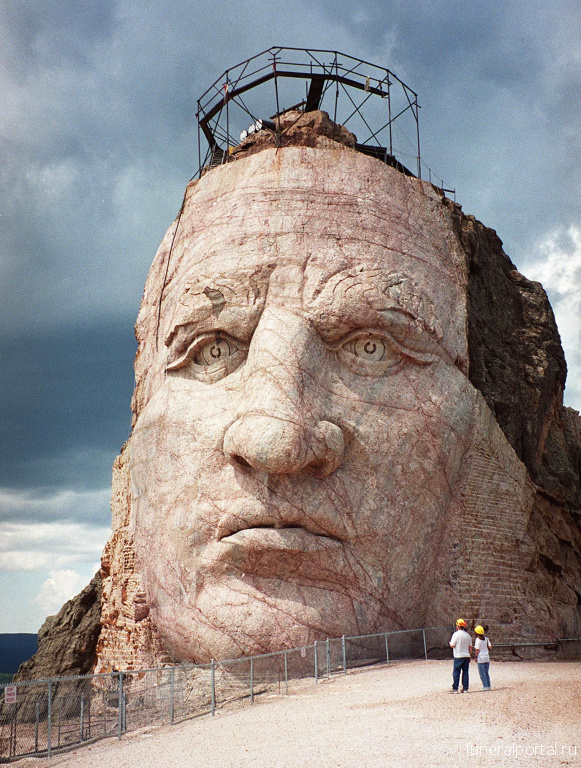A view of the Crazy Horse Memorial in South Dakota from late 2019, more than 70 years after it was begun. Courtesy Wikimedia Commons.
By Katherine Keener
When asked where you might find the largest face in the US, one might think of the Statue of Liberty, whose face is eight feet tall, or better yet, Mount Rushmore, which depicts the visages of four US presidents at around 60 feet or so. However, the real answer lies not far from the Mount Rushmore National Memorial. In fact, just 17 miles away in South Dakota is where you’d find the Crazy Horse Memorial which, even in its unfinished state, is the largest face found in the US and the world, for that matter – it measures in at about 87.5 feet.
Seems like an odd fact but the Crazy Horse Memorial is an interesting monument that is still in progress more than 70 years after it was begun.
The project was initiated in 1939 as a response to the construction of Mount Rushmore, which bore into the Black Hills, an area considered to be sacred to Native American tribes in the area. Polish-American sculptor Korczak Ziolkowski was contacted by Henry Standing Bear, a Lakota elder, who wanted to memorialise his people showing “that the red man had great heroes, too,” as The New Yorker quoted Standing Bear.

Sculptor Korczak Ziolkowski stands before the mountain where he would begin the Crazy Horse Memorial in the Black Hills of South Dakota in the 1950s. Courtesy Wikimedia.
Ultimately, Tasunke Witko, best known as Crazy Horse, was an obvious choice for the monument. An Oglala Lakota warrior and chief, Crazy Horse was integral in defeating General Custer at the Battle of Little Bighorn. According to Tatewin Means, “he never conceded to the white man.”
Work on the monument started in earnest in 1948 after the necessary land was obtained. With very little money, and refusing to accept federal funding, Ziolkowski worked tirelessly, alone, and without a lot of the tools that would’ve aided such an endeavor. When completed, the memorial will depict Crazy Horse, hair blowing in the wind, atop a horse, as he points forward. In 1951, Ziolkowski anticipated the project would take 30 years, but at the time of his death in 1982, the face of Crazy Horse wasn’t even finished.

A model of what the Crazy Horse Memorial will look like when completed set against the real work. Courtesy Flickr Commons.
Since his death, his widow, Ruth (who died in 2014), and his children have continued work on and operate the monument. In 1998, Crazy Horse’s face was finally unveiled, just a few decades behind schedule. The Crazy Horse Memorial is run today by Ziolkowski’s children while progress still creeps along. More than a million tourists flock to the South Dakota landmark each year, paying an entrance fee that helps support the project.
Many view the memorial in a positive light. It does indeed highlight the Native American people who were vastly oppressed during the creation of the US as we know it today and it perhaps represents the opposite side of the Mount Rushmore coin. However, some feel less favourable about the sculpture.
One issue is that the Crazy Horse Memorial is taking shape at the peak of Thunderbolt Mountain which is a part of the Black Hills. According to records of Crazy Horse, he was a very unassuming and humble man. Although he was a great warrior, he was never photographed and he never wore elaborate things. Thus, many Native Americans question if a massive monument – so massive that if all four presidents heads from Mount Rushmore were stacked on top of each other, they would only come about half way up the Crazy Horse Monument when completed – honours the Lakota man in an appropriate manner.
Moreover, as pointed out by The New Yorker, when the project was initiated by Standing Bear, he not only wanted to show that the Native American people had leaders, as quoted above, but he continued by saying that the monument was “to be entirely an Indian project under my direction.” Considering that, it is questionable if the monument as it is today reflects this want.


This leads to another issue, which comes down to who the monument glorifies. For some, the project started out as a true homage to the Native people who lived and prospered in North America long before Europeans settled in. Over time, though, the memorial seemed to become more of a glorification of Ziolkowski and his family. For instance, in the museum at the memorial, a video states that Crazy Horse died on September 6th, which was Ziolkowski’s birthday. However, census data shows that Crazy Horse died on the 5th of September. After Ziolkowski’s death, Ruth and then one of her sons perpetuated the idea that “the Indians believe Crazy Horse’s spirit roamed until it found a suitable host—and that was Korczak,” a man who was not Native American himself.
These are only a few of the major reasons that a large sect of Native American people take issue with the monument. Not to mention the fact that a man, who was not Native American, and his family, who also are not Native American, now profit off a site completely tied up with Native American history.
The monument’s progress continues, and it is without question an incredible feat. However, as people around the world grapple with problematic statues and as museums question how to handle monuments, perhaps the Crazy Horse Memorial will stand as a testament to taking a critical look at the moments we encounter and how we honour the heroes of the past.








